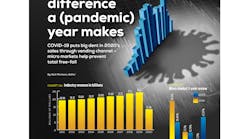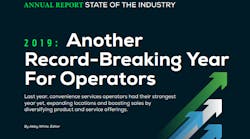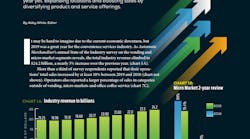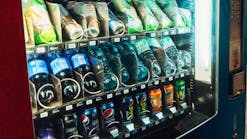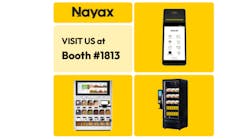Automatic Merchandiser's 2021 State of the Industry for Vending and Micro Market Report shows a year of rapid recovery
A strong rebound in sales in all major food and beverage categories through vending machines and at micro markets led to a 46% increase in 2021 over the previous year’s revenue, according to Automatic Merchandiser’s latest State of the Industry report. Sales in the unattended retail channel totaled $19.4 billion in 2021, compared with $13.3 billion in 2020, when vending and workplace refreshments suffered their biggest downturn ever.
USEFUL LINKS
Th 2021 Automatic Merchandiser State of the Industry report is featured in the 2022 June/July issue.
Click here to view a PDF of the report.
The vending industry’s revenue was initially expected to fully return to, or surpass, 2019’s benchmark revenue high of $22.2 billion, after falling 45% in 2020, the first year of the pandemic that brought months-long lockdowns. Conversely, lingering at-home work patterns intensified by coronavirus variants, rising inflation and supply chain disruptions worked together to hinder a stouter recovery in 2021, and continue to do so this year. Vending operators tried to beat back this perfect storm of headwinds with price increases, which had a limited impact due to key product shortages. In the end, 2021 remained $2.8 billion below 2019’s pre-COVID high-water mark.
U.S. vending operators and the businesses they serve did their best to adjust to the new economic realities of the COVID world, with some success. Those realities are profoundly affecting workplace service providers more than any other merchant class. And the new reality that became evident in 2020 is a game-changer: the performance of vending, micro markets, coffee service and contract foodservice is no longer tied to employment like it had always been. Low unemployment rates no longer translate to more people at offices as key U.S. employers have transitioned to remote or hybrid work models.
Last year, in fact, total job numbers grew 4.6%, according to the Congressional Budget Office, making 2021 the seventh-fastest year of job growth since the end of World War II. In general, according to CBO’s relative pre-pandemic projections, adjusted for population, the U.S. economy in 2021 was still 4.4 million jobs short; additionally, 2.7 million fewer people were employed as of December than the CBO had anticipated pre-COVID. So, there’s room for at-work employee population growth in the coming years.
All vended categories up
Regardless of the unpredictable nature of the COVID-influenced labor market, the pandemic has established the vending operator as an essential part of the business supply chain. The operator’s ability to provide reliable services to workplaces was reflected in dramatic improvements in all major product categories last year.
Combined vending machine and micro market revenue gains were:
- Healthy items (including plant-based) up 200%.
- Food (sandwiches, salads, entrées) up 170%.
- Snacks (salted, bars, mixes, etc.) up 120%.
- Packaged cold drinks up 92%.
- Candy (chocolate and non- chocolate) up 85%.
- Confections (pastries, cookies, etc.) up 64%.
- Ice cream/frozen items up 50%.
- Hot drinks (vended coffee, tea, cocoa, etc.) up 40%.
- Miscellaneous “other” items up 26%.
As expected
In the overall retail and foodservice economy, sales of plant-based foods grew three times faster than total food sales in 2021, according to data compiled by the Plant Based Foods Association, the Good Food Institute and wellness-focused research firm SPINS. Their data showed plant-based growth at 6.2% in 2021, bringing the total plant-based market value to a record high of $7.4 billion. Likewise, micro markets and vending installations saw their strongest year in plant-based sales, which are currently recorded as part of AM’s “healthy” category. Sales in the vended healthy segment (combined vending and micro market) beat 2019’s high by 25%, increasing from $1.4 billion to $1.8 billion.
Packaged cold drinks held the No. 1 rank among the convenience product categories last year, generating 25% of revenue, or $4.8 billion. Always dynamic categories, packaged snacks, confections and candy jointly constituted the largest market share of convenience services. In 2021, these items in these categories led the way in dollar volume, representing 38% of all sales through vending machines and 34% of all sales in micro markets, or $6.3 billion and $1.2 billion, respectively.
Operation snapshot
Most (47%) of this year’s survey participants defined their businesses as full-line operations providing vending machines, micro markets and office coffee services. About 10% were traditional full-line vending operations without micro markets, while just under 5% operate micro markets only. And some 19% of the businesses claim to be candy, snack and beverage only operations. These unattended retail areas, prevalent in workplaces, are collectively known as convenience services. About 10% said they were bottlers.
Most of this year’s survey participants (70%) said they operated between one and nine routes, and 40% employed between one and five people. Almost 40% of all operators were involved in acquiring or divesting routes or parts of their operation. And most vendors (75%) said their cold drink machines, ranging from count between 5% and 100%, were supplied by a bottler. Some 71% of operators said the number of locations they served in 2021 increased.
During the 2021 recovery, the nation’s operators had an estimated 1.97 million vending machines on location, increasing from 1.74 million the year prior. Last year’s micro market installed base climbed to 25,750, up 8.5%, compared with 23,745 installed markets in 2020. Manufacturing and office locations represented a little more than half of the convenience services demographic last year.
Shelf shock
For most merchant classifications, 2021 was a year of empty shelves, severely impacting U.S. retail sales. Empty shelves were evident in the vending and micro market segment, too, as operators struggled to procure common confections and beverage products that were once abundant. According to a NielsenIQ analysis of on-shelf availability, empty shelves cost U.S. retailers an estimated $82 billion in missed sales last year. In the convenience services sector, product shortages significantly hampered the recovery.
Vending, and more recently, micro markets, rose in response to market challenges, and it has demonstrated an ability to keep on doing so. The marketplace vending operators serve has undergone a profound transformation in the past two years and their workplace clients recognize the value proposition they bring to their businesses. All signs point to continued recovery for the industry. ■
About this study (or methodology)
Data in Automatic Merchandiser’s State of the Industry report are compiled from a survey sent to operators in the spring. It collects responses from vending and micro market providers, as well as snack and soda operations. The State of the Industry report looks at performance results in major product categories.

Nick Montano
Contributing editor Nick Montano is passionate about covering news in the vending, office coffee service and micro market industry. He brings more than two decades’ experience to AM and VMW as a business journalist. His industry roots go way back; his first jobs were managing the stockroom of a full-line vending company and filling in for vacationing route drivers during his high school summer breaks.

